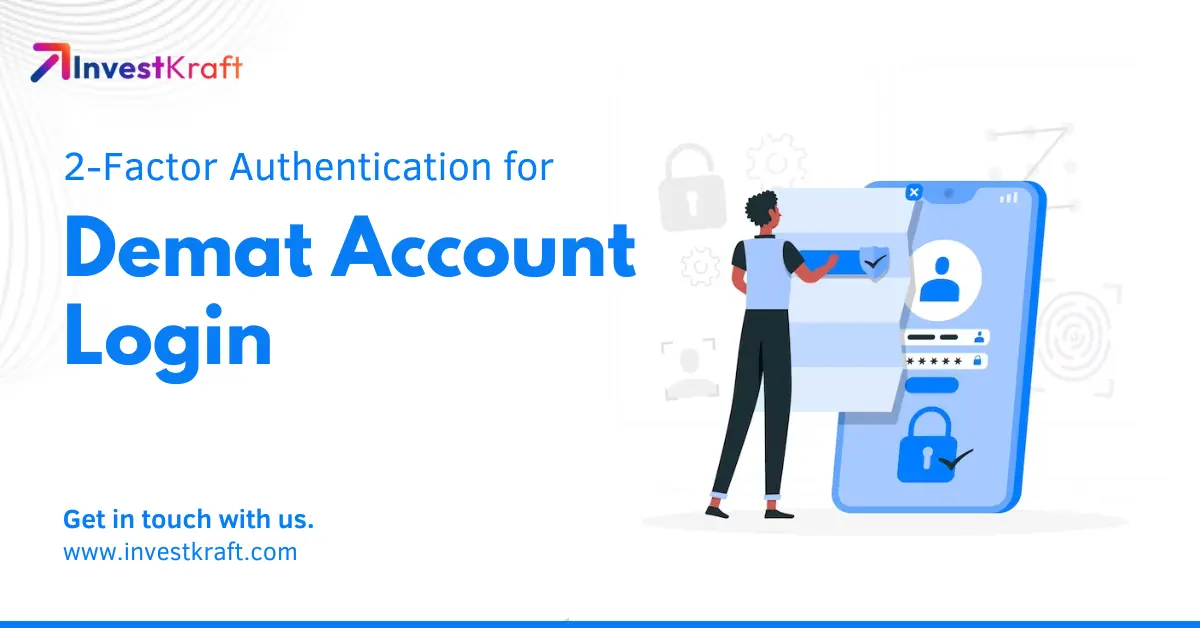How to Activate Two-factor Authentication on Demat Account?

To level up the security level of the Demat account used by stock market investors, several steps have been taken by the SEBI. All these steps are intended to make stock-based transactions more secure and valuable than ever. In addition, this also endeavors to enhance the overall stock trading experience of users. Among various security measures taken by the Securities and Exchange Board of India, one concrete step is 2-factor authentication.
It was made mandatory for the Demat account holders to enable 2-factor authentication before 30 September 2022. If not done, they were unable to use the Demat account for any further transactions therein. If you want to know more about 2-factor authentication, this post will help know it in detail so that you can make better use of this security feature and trade in stocks confidently.
What is Two-Factor Authentication?
2FA, or two-factor authentication refers to a type of identity verification procedure that asks users to provide two elements of evidence like a password and a one-time passcode. Doing this would ascertain their identity and give them access to an online account or other personal details.
Multi-factor authentication (MFA) refers to any authentication procedure that requires users to provide at least two pieces of proof, and 2FA is the most widely used type of MFA.
The reason 2FA is so popular is that it enhances account security. Passwords used by users are readily hacked or faked. By demanding a second factor, 2FA raises the security bar even more. To breach a system, hackers must not only have two credentials but also frequently a challenging-to-hack second factor, such as a time-limited passcode or fingerprint. The two factors falling in this type of authentication are the knowledge factor and the possession factor.
What do knowledge factor and possession factor authentication mean?
Knowledge factor authentication refers to the use of an element that is only known to the users such as a security PIN or password. On the other hand, possession factor authentication asks for an element that is confidential to the users such as a security token or one-time password. This OTP or token needs to be sent to the user on both their registered email ID and mobile number.
How does two-factor authentication work?
The system asks for the user's first factor of authentication when requesting to access a resource that is secured by 2FA, such as a business network. This initial factor is frequently a username and password pair.
The system requests an additional factor if the first one is legitimate. Second factors come in a wider variety and might include biometrics, temporary codes, and more. Only when both conditions are met can the user access the resource.
Even while 2FA is often connected to computer systems, it may also protect real estate and places. For instance, entry to a restricted building may require the flashing of an ID badge and a successful fingerprint scan.
How to enable two-factor authentication in a Demat account?
Here is a step-by-step guide on how to activate 2-factor authentication on a majority of trading platforms.
Step 1: Visit the website or mobile application that is used by you to access your Demat account.
Step 2: Sign in and jump to your Profile
Step 3: Go to Password Option / Security Option
Step 4: Press Select on two-factor authentication
Step 6: You will get a one-time password (OTP) on your mobile and registered email ID.
Step 7: You must enter the OTP on the website of the Demat account service provider. The site or the App may ask you to enter your fingerprint or scan a QR code as well.
Once the aforementioned procedure is done, your Demat account's two-factor authentication has been successfully managed. There may be minor variations in the ways that different systems implement two-factor authentication. For the most straightforward and flawless completion of the procedure, make sure you adhere to the directions precisely.
Even if the regulatory authorities' imposed structures and standards might be burdensome at times, it's important to remember that ultimately, customers will gain from the enhanced security and safety. So, it could be worth it to put up with a little annoyance in exchange for increased safety.
FAQs
Q. What are the major benefits of 2-factor authentication?
- The major benefits of 2-factor authentication are device compatibility, simplicity, and improved access.
Q. What is push-based 2FA?
- Push-based 2FA enhances SMS and TOTP 2FA by introducing more security layers and making it easier for consumers to utilize. Using several authentication factors, push-based 2FA verifies a user's identity in a way that previous approaches are unable to.
Q. Is it possible to disable 2-factor authentication?
- Yes, it is always possible to disable 2FA from a Demat account.
Conclusion
2-factor authentication is a wonderful security feature that keeps the sensitive information of the users and the securities safe and secure. AT present, this feature is embraced by almost all stockbrokers in India. By introducing an additional layer of protection, 2FA aids in preventing unwanted access. For access, hackers require a second factor even if they manage to acquire a password. Furthermore, hackers would need to fabricate biometrics, imitate behaviors, or steal actual equipment to get these secondary factors, which are often more difficult to steal than knowledge factors.
Verify Phone Number
Related Post

Peer-to-Peer (P2P) Lending in India: Complete 2025 Guide to Risk, Returns, RBI Rules & Best Platforms
Peer-to-peer lending, also known as P2P lending, is when one individual lends money to another...
Read more...
Top 10 P2P Lending Companies in India 2026 (RBI Registered NBFC-P2P Platforms)
Peer-to-peer lending, commonly known as P2P lending, has become one of India’s fastest-growing...
Read more...
Top 10 Microfinance Companies in India – List, Benefits & RBI Updates
Microfinance institutions (MFIs) play a pivotal role in promoting financial inclusion in India...
Read more...
10 Best Foreign Banks in India 2025: Complete List with Features & Services
Foreign Banks in India play a very important role in offering world-class financial services,...
Read more...
Top Private Sector Banks in India 2026: List, Strengths, Services & Key Updates
Private sector banks in India have played a very important role in the country's financial sce...
Read more...
Top 10 Government Banks in India 2026: A Comprehensive Guide
Government banks, also known as Public Sector Banks (PSBs), form the backbone of India’s banki...
Read more...
Top Regional Rural Banks in India 2025–2026: List, Strengths, Benefits & Updates
Regional Rural Banks (RRBs) play a vital role in India’s rural and semi-urban financial ecosys...
Read more...
Top 10 Co-operative Banks in India 2025–2026 (With Customer Care Numbers)
Co-operative Banks are an integral part of India’s financial ecosystem, especially for local c...
Read more...
Top Payment Banks in India 2026: Services, Deposit Limits, Features & Latest Updates
Payment Banks in India were introduced as part of the financial inclusion strategy by the Rese...
Read more...
List of Top Agricultural Banks in India 2026: A Comprehensive Guide
Agriculture remains the backbone of India’s economy, employing over half of the country’s population...
Read more...Reach out to our Experts if you have any Doubts
Like the best things in life, Consultations @InvestKraft are free
Drop a Mail or give us a Missed Call & Begin your Investment Journey here






